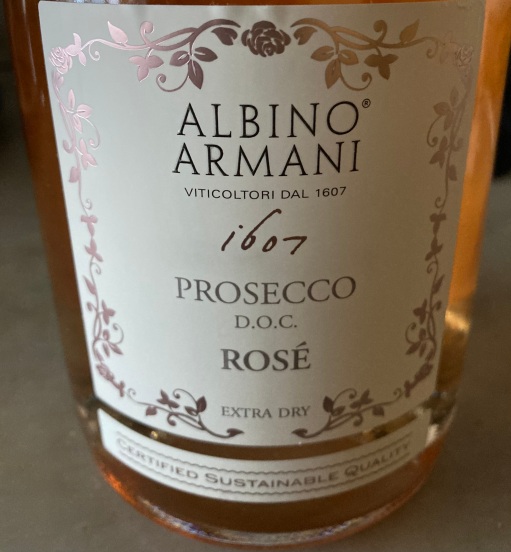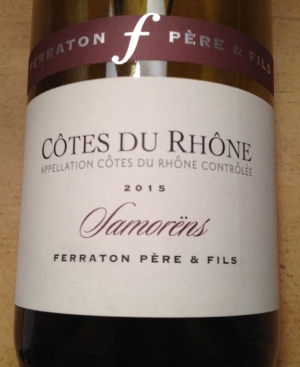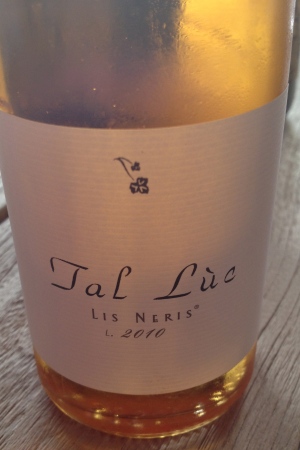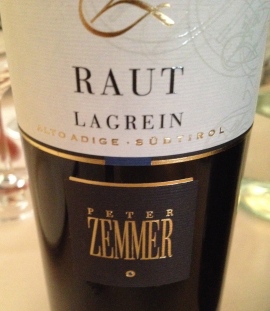Riccardo Gabriele of PR Communicare Vino, an Italian PR agency, represents some of the top Italian wineries. He asked me if I would like to meet with one of his new Italian producers for lunch in NYC, Mike Costanzo of Briganti Wines. Mike is an American and has a winery in Abruzzo. What Riccardo did not mention was that Mike was a former MLB third baseman and played for the Cincinnati Reds. I have met a lot of winery owners over the years from all over the world, but Mike’s association with baseball was a first.
 We met at Fresca by Scotto for lunch with Mike and his girlfriend Lauren.
We met at Fresca by Scotto for lunch with Mike and his girlfriend Lauren.
Mike is very personable and charming and we hit it off right away. We talked mostly about wine and food and a little about baseball.
Mike said Briganti is a brand that emerged from the well-respected Risogna Vini, an agricultural company located in Orsogna, Chieti, that has been producing high quality wines in the Abruzzo Region since 2017.
 The Abruzzo Region of Italy, located to the east of Rome, has everything going for it. There are beautiful national parks, a long coastline on the Adriatic, the rugged snowcapped Apennine Mountains, and little medieval towns perched precariously on hill tops. Abruzzo is situated between the Adriatic Sea and the Gran Sasso and Majella massif. It is one of the most unspoiled regions of Italy with three national parks and more than ten national and regional natural reserves. Abruzzo geographically is more central than southern Italy, but due to its connection with the old Kingdom of the Two Sicilies, it is considered part of the South. Most vineyards are in hilly areas, of which 75% are in the province of Chieti.
The Abruzzo Region of Italy, located to the east of Rome, has everything going for it. There are beautiful national parks, a long coastline on the Adriatic, the rugged snowcapped Apennine Mountains, and little medieval towns perched precariously on hill tops. Abruzzo is situated between the Adriatic Sea and the Gran Sasso and Majella massif. It is one of the most unspoiled regions of Italy with three national parks and more than ten national and regional natural reserves. Abruzzo geographically is more central than southern Italy, but due to its connection with the old Kingdom of the Two Sicilies, it is considered part of the South. Most vineyards are in hilly areas, of which 75% are in the province of Chieti.
Mike said the name Briganti pays homage to the region’s past, as Abruzzo is famous for being the birthplace of the brigandage movement in Italy. During the decade between 1860 and 1870 following Italy’s unification, the Briganti d’Abruzzo experienced its greatest development. Unification had the immediate effect of creating a huge increase in taxes that generated hunger, famine and widespread poverty. In response to a series of injustices, appropriations and violations, local people formed gangs to rebel against what was happening and fight for their rights. The gangs became roving bands that were known as brigantine.
Mike honors the memory of these brigantini with the names and pictures on the labels of the wine.
 Terre di Chieti IGP “Mecola” made from 100% made from 100% Pecorino. There are 1,600 plants per hectare. The training system is pergola and guyot (4,000 vines per hectare for the double guyot). Harvest takes place in October. Carefully selected grapes are destemmed then cry-maceration of the crushed grapes takes place for extraction of color and flavor. This is followed by a soft pressing of the grapes and temperature controlled fermentation in stainless steel tanks for 30 days. The wine has hints of lemon blossom, peach a hint of jasmine, floral notes of acacia and a slight mineral edge.
Terre di Chieti IGP “Mecola” made from 100% made from 100% Pecorino. There are 1,600 plants per hectare. The training system is pergola and guyot (4,000 vines per hectare for the double guyot). Harvest takes place in October. Carefully selected grapes are destemmed then cry-maceration of the crushed grapes takes place for extraction of color and flavor. This is followed by a soft pressing of the grapes and temperature controlled fermentation in stainless steel tanks for 30 days. The wine has hints of lemon blossom, peach a hint of jasmine, floral notes of acacia and a slight mineral edge.
Mike said Pecorino is one of Italy’s indigenous grape varieties cultivated in the hills of Abruzzo. It is known for its refreshing acidity, floral aromas, stone fruits, tropical fruit flavors and minerality. Mike said that the wine is named for Mecola, an Abruzzese ancestor who proudly defended the freedoms of the farmers of Abruzzo in the 1860s during the unification of Italy.
 Terre Di Chieti IGP Pinot Grigio “Filomena D’Orazio” made from 100% Pinot Grigio. There are 4,000 wines per hectare and the training system is guyot. Harvest is at the end of August. Carefully selected grapes are soft pressed and fermentation is in temperature controlled stainless steel for 10/15 days. The wine remains in stainless steel until it is bottled. The wine has hints of citrus fruit, chestnut, a touch of honey and a note of hazelnuts.
Terre Di Chieti IGP Pinot Grigio “Filomena D’Orazio” made from 100% Pinot Grigio. There are 4,000 wines per hectare and the training system is guyot. Harvest is at the end of August. Carefully selected grapes are soft pressed and fermentation is in temperature controlled stainless steel for 10/15 days. The wine remains in stainless steel until it is bottled. The wine has hints of citrus fruit, chestnut, a touch of honey and a note of hazelnuts.
Mike said that his winemaking philosophy reflects the passion of those who fought against oppression and sought refuge in cultivating the land. This wine celebrates Filomena D’Orazio, who represents the strength and courage of her time. This is their signature Pinot Grigio.
 Cerasuolo D’Abruzzo DOC “Ciuccolo” this rosé is made from 100% Montepulciano d’Abruzzo. There are 1,400 vines per hectare and they are pergola trained. Harvest is in the first 10 days of October. The grapes are crushed with maceration on the skins for 2/4. Then a soft pressing followed by a cold soak clarification. Fermentation is in stainless steel at a controlled temperature for 10/12 days. The wine remains in stainless steel until it is ready to bottle. The wine has hints of strawberries, pomegranate, and cherry and it is medium bodied with crisp acidity.
Cerasuolo D’Abruzzo DOC “Ciuccolo” this rosé is made from 100% Montepulciano d’Abruzzo. There are 1,400 vines per hectare and they are pergola trained. Harvest is in the first 10 days of October. The grapes are crushed with maceration on the skins for 2/4. Then a soft pressing followed by a cold soak clarification. Fermentation is in stainless steel at a controlled temperature for 10/12 days. The wine remains in stainless steel until it is ready to bottle. The wine has hints of strawberries, pomegranate, and cherry and it is medium bodied with crisp acidity.
Mike said Cerasuolo d’Abruzzo is a hearty, robust rosé, with rich color and fresh fruit flavors. It has stood the test of time. This wine is named in honor of the brigand known as “Ciuccolo” who fought for the rights of his fellow citizens during the unification of Italy in the 1860’s. His legend lives on and is timeless.
 Montepulciano D’Abruzzo DOC “Ninco Nanco” made from 100% Montepulciano D’Abruzzo. There are 1,600 vines per hectare and the training system is pergola and guyot. The grapes are hard harvested in October. At the winery the grapes are destemmed, crushed and transferred to fermentation tanks. There is daily pumping over for iteration of color and tannins. After fermentation is done the wine goes into concrete tanks and malolactic fermentation is completed in 7/10 days. The wine remains in concrete until it is ready to bottle. The wine has hints of black cherry, raspberry, red plum, hint of tobacco and a touch of spice.
Montepulciano D’Abruzzo DOC “Ninco Nanco” made from 100% Montepulciano D’Abruzzo. There are 1,600 vines per hectare and the training system is pergola and guyot. The grapes are hard harvested in October. At the winery the grapes are destemmed, crushed and transferred to fermentation tanks. There is daily pumping over for iteration of color and tannins. After fermentation is done the wine goes into concrete tanks and malolactic fermentation is completed in 7/10 days. The wine remains in concrete until it is ready to bottle. The wine has hints of black cherry, raspberry, red plum, hint of tobacco and a touch of spice.
Mike said that this wine is in named honor of Ninco Nanco, a dedicated patriot of Italy’s independence and a believer in social justice, who represents the power and strength of the red wines from Abruzzo. Montepulciano is rich and bold with natural acidity, ripe red/black fruits, and robust herbal and spicy notes.
 The wine was a perfect combination with the pork and red peppers we had for lunch.
The wine was a perfect combination with the pork and red peppers we had for lunch.
After tasting the wines I asked Mike what the retail price would be, and he said between $16 and $18 a bottle. These wines are a fantastic value for the money.
Mike is looking for a distributor in the NY and his wines are available in other parts of the US.
As a lifelong baseball fan, I asked Mike about his career in the Major Leagues. We talked a lot about it and Mike said that one of the highlights of his career was at Yankee Stadium where he got his first major hit. Derek Jeter, the great Yankee shortstop, retrieved the ball and gave it to him. He will never forget that moment and meeting Jeter.


 Prosecco Rosé DOC Extra Dry Millesimo NV made from 90% Glera and 10% Pinot Noir. The production area is Alta Grave Friulana and the training system is Guyot. When the cuveé is ready a long second fermentation takes place in pressure tanks ( Charmat method) for at least 60 days in order to obtain a more refined perlage and complex aromas from the Pinot Noir. This is a fruit forward wine with hints of lilacs, strawberry and raspberry. $16
Prosecco Rosé DOC Extra Dry Millesimo NV made from 90% Glera and 10% Pinot Noir. The production area is Alta Grave Friulana and the training system is Guyot. When the cuveé is ready a long second fermentation takes place in pressure tanks ( Charmat method) for at least 60 days in order to obtain a more refined perlage and complex aromas from the Pinot Noir. This is a fruit forward wine with hints of lilacs, strawberry and raspberry. $16 Pinot Grigio Friuli Grave DOC 2020 The soil composition is loose and well aired and composed of typical calcareous white river stones dragged down by the flooding of the alpine brooks. The training system is Guyot. Fermentation and maturation is in stainless steel tanks in contact with the grapes’ own yeasts until the wine is bottled. The wine has hints of citrus, pears, apples and a touch of almonds in the aftertaste with good minerality. $13
Pinot Grigio Friuli Grave DOC 2020 The soil composition is loose and well aired and composed of typical calcareous white river stones dragged down by the flooding of the alpine brooks. The training system is Guyot. Fermentation and maturation is in stainless steel tanks in contact with the grapes’ own yeasts until the wine is bottled. The wine has hints of citrus, pears, apples and a touch of almonds in the aftertaste with good minerality. $13 Pinot Grigio “Colle Ara” Valdadige Terradeiforti DOC 2020 made from 100% Pinot Grigio from selected grapes cultivated on ancient
Pinot Grigio “Colle Ara” Valdadige Terradeiforti DOC 2020 made from 100% Pinot Grigio from selected grapes cultivated on ancient Valpolicella Ripasso DOC Classico Superiore 2018 made from Corvina, Corvinone and Rondinella from high hills in the Valpolicella Classico production area at 300/500 meters. The soil is calcareous deposits on volcanic rock. The training system is traditional pergola Veronese on stone wall terraces, called marogne in local dialect. The fresh Valpolicella wine is poured over the Amazon pomace that is still full of un-fermented sugars and aromatic compounds that start a second fermentation. Then punching down the cap takes place and also some delestage until the complete depletion of the sugar content making the new wine rich and sweet in structure with sweet tannins. The wine is aged in oak barrels. The wine has hints of cherry and other red fruits with a touch of chocolate and a note of coffee. $20
Valpolicella Ripasso DOC Classico Superiore 2018 made from Corvina, Corvinone and Rondinella from high hills in the Valpolicella Classico production area at 300/500 meters. The soil is calcareous deposits on volcanic rock. The training system is traditional pergola Veronese on stone wall terraces, called marogne in local dialect. The fresh Valpolicella wine is poured over the Amazon pomace that is still full of un-fermented sugars and aromatic compounds that start a second fermentation. Then punching down the cap takes place and also some delestage until the complete depletion of the sugar content making the new wine rich and sweet in structure with sweet tannins. The wine is aged in oak barrels. The wine has hints of cherry and other red fruits with a touch of chocolate and a note of coffee. $20






























































